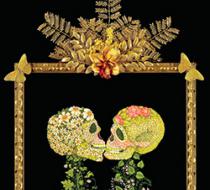Art AIDS America traveling exhibition Favorite
If you visit the Art AIDS America exhibition expecting to see activist slogans and memorial pieces along with some art-world superstars, you won’t be disappointed—Keith Haring, Robert Mapplethorpe and the “Silence = Death” slogan are present and accounted for—but you might also walk through the show scratching your head in confusion.
That’s because the exhibit highlights a less-obvious style of art, one that may cause you to wonder, “Huh? How is this about AIDS?” Nonetheless, as co-curators Jonathan David Katz and Rock Hushka set out to prove, the 100-plus pieces in the exhibit do more than capture the breadth of the U.S. epidemic and inspire discussion about the disease; they also illustrate, in Hushka’s words, “how the artists’ response to the epidemic utterly changed artistic practice in the United States.”
But first, an overview: A decade in the making, the exhibition kicks off with a preview in June at the ONE Archives Gallery & Museum in West Hollywood before opening October 3 at the Tacoma Art Museum in Washington, where Hushka is the chief curator (Katz is a professor with the University at Buffalo, SUNY). The show then moves in early 2016 to the Zuckerman Museum of Art in Kennesaw, Georgia, before closing at the Bronx Museum of the Arts in New York. At this point, dates are tentative, so double-check with each institution.
The exhibit is divided into pre- and post-cocktail eras—when combination therapy transformed HIV from a death sentence to a “manageable” chronic illness—and it spans more than three decades. Katz says the show’s oldest piece, Izhar Patkin’s “Unveiling of Modern Chastity,” from 1981, “is, as far as I know, the first work of art about AIDS.” Made of rubber paste, latex theatrical wounds and printing ink on stretched canvas, it’s a putrid green surface pitted with lesions, an obvious reference to Kaposi’s sarcoma.
Katz and Hushka scoured the country for works of both artistic quality and historic or cultural importance, most notably pieces by regional and community artists as well as art featuring minority populations.






